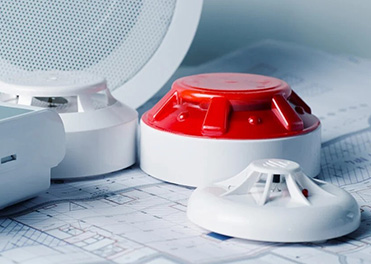What Are Fire Detectors? Different Types And How Do They Work

In our daily lives, we often take safety for granted. However, fire, a force both awe-inspiring and destructive, lurks ever-present, reminding us of its potential danger. That’s where fire detectors come in, acting as silent guardians against this unseen threat.
This blog aims to be your comprehensive resource for understanding the world of fire detectors. We’ll explore the different types available, delve into installation and maintenance practices, and discuss crucial fire safety considerations.
Through real-life examples and informative explanations, we’ll demonstrate the effectiveness of fire detectors in saving lives. We’ll also address commonly asked questions and provide you with valuable resources to deepen your knowledge.
So, join us as we embark on this journey towards fire safety. Let’s equip ourselves with the knowledge and tools necessary to protect ourselves and our loved ones from the devastating consequences of fire. Remember, fire safety is not just a matter of technology; it’s a collective responsibility. Together, we can create a safer environment for everyone.
What Are Fire Detectors?
Fire detectors are life-saving devices that sense the presence of fire and trigger an alarm to alert occupants and emergency services. They detect various fire indicators like smoke, heat, infrared light, or gas, providing early warning to evacuate and minimize damage. These detectors can be standalone units or integrated parts of a larger fire alarm system, ensuring timely response and potentially saving lives.
Importance Of Fire Detectors
Fire detectors are not just technological marvels; they are silent guardians, standing watch over our homes and workplaces, ready to spring into action at the first sign of danger. They are the early warning system that can mean the difference between life and death, between a minor inconvenience and a devastating loss.
Here’s why fire detectors are an essential part of your safety arsenal:
• Early Detection: Early detection is key in any emergency, and fire detectors excel at this. They can sense smoke, heat, or even infrared light, giving you precious seconds to react. These vital seconds can make the difference in safely evacuating yourself and your loved ones.
• 24/7 Protection: Fire doesn’t wait for convenient hours to strike. With fire detectors, you have round-the-clock protection, even when you’re asleep or away. This gives you peace of mind and ensures that you’re always alerted to potential danger.
• Reduced Damage: Early detection means faster response. Fire detectors can trigger alarms that not only alert occupants but also notify emergency services. This prompt response can significantly reduce fire damage, protecting your property and belongings.
• Saving Lives: Ultimately, the most crucial role of fire detectors is saving lives. By giving you early warning, they enable you to evacuate safely before the fire spreads, preventing potentially fatal injuries.
Investing in fire detectors is an investment in safety, peace of mind, and potentially, your life. Choose wisely, install them correctly, and rest assured that these silent guardians are always there, watching over you and your loved ones.
Remember, fire detectors are not a substitute for good fire safety practices. Always follow fire safety guidelines and have an escape plan in place.
Types Of Fire Detectors And How They Work
Fire detectors are the silent heroes in our homes and workplaces, constantly vigilant against the threat of flames. These life-saving devices act as our early warning system, providing precious seconds to react and potentially avoid catastrophe. Understanding the different types of fire detectors and how they work is key to choosing the right ones for your specific needs and ensuring optimal safety.
1. Smoke Detectors:
The two primary types of smoke detectors, photoelectric and ionization, utilize distinct technologies to detect the presence of fire. Understanding their individual strengths and weaknesses is crucial for selecting the most effective smoke detector for your specific needs.
Photoelectric Detectors:
Mechanism:
Imagine a tiny flashlight shining through a hallway. As long as nothing obstructs the beam, a sensor on the other side happily receives the light. But when smoke, like dust motes, enters the hallway, it scatters the light beam, disrupting the flow of photons to the sensor. This sudden interruption triggers the alarm, alerting you to the potential danger.
This is essentially how photoelectric detectors work. They use a light source, typically a light-emitting diode (LED), and a photoelectric sensor located in a sealed chamber. When smoke particles enter the chamber, they scatter the light beam, reducing the amount of light reaching the sensor. This decrease in light triggers the alarm, signaling the presence of smoke.
Strengths:
• Superior for smoldering fires: These fires tend to produce large amounts of visible smoke but little heat. As photoelectric detectors are sensitive to smoke particles, they excel at detecting these types of fires and providing early warnings.
• Reduced false alarms: Unlike ionization detectors, photoelectric detectors are less susceptible to false alarms triggered by cooking fumes, dust, or humidity. This allows for a more reliable and accurate detection of actual fire emergencies.
Weaknesses:
• Slower response to flaming fires: Flaming fires typically produce less visible smoke but high heat. Photoelectric detectors may take slightly longer to detect these types of fires compared to ionization detectors.
• Maintenance needs: Regular cleaning of the chamber is crucial to ensure optimal performance. Dust accumulation on the sensor can affect its ability to detect smoke particles.
Ionization Detectors:
Mechanism:
Imagine a room filled with invisible electrical currents flowing freely between two charged plates. Now, picture smoke particles entering the room. These particles disrupt the flow of electricity, causing a decrease in the current. This sudden change triggers the alarm, indicating the potential presence of smoke.
This is the basic principle behind ionization detectors. They utilize a small amount of radioactive material, typically americium-241, to ionize the air within the chamber. Ionization creates positively charged ions that flow freely between two electrically charged plates. When smoke particles enter the chamber, they attach to the ions, disrupting the flow of electricity. This reduction in current triggers the alarm, signaling the potential presence of smoke.
Strengths:
• Faster response to flaming fires: These fires emit small smoke particles and high heat, triggering a quicker response from ionization detectors compared to photoelectric detectors.
• Less maintenance: Ionization detectors require less frequent cleaning compared to photoelectric detectors.
Weaknesses:
• More prone to false alarms: Cooking fumes, dust, and even humidity can trigger false alarms in ionization detectors. This can be disruptive and lead to a sense of complacency, potentially diminishing the urgency of real fire alarms.
• Exposure to radioactive material: While the amount of radioactive material used is minimal and poses minimal risk, some people may prefer to avoid any exposure to radiation.
Both photoelectric and ionization detectors offer valuable protection against fire. The best choice for you will depend on your individual needs and preferences. If you are concerned about smoldering fires or false alarms, a photoelectric detector might be the better option. However, if you are more concerned about flaming fires, an ionization detector might be preferable.
For optimal protection, consider using a combination smoke detector that incorporates both photoelectric and ionization technologies. This provides a comprehensive safety net, ensuring that you are alerted to a wider range of potential fire hazards.
Remember, regardless of the type you choose, regular testing and maintenance are crucial to ensure the continued effectiveness of your smoke detectors. By taking these steps, you can empower these silent guardians to protect you and your loved ones from the dangers of fire.
2. Heat Detectors:
Heat detectors play a vital role in fire detection, especially in situations where smoke might not be readily visible. Understanding the two main types, fixed-temperature and rate-of-rise detectors, is crucial for choosing the most suitable option for your specific needs.
Fixed-Temperature Detectors:
Mechanism:
Imagine a thermometer with a built-in alarm. When the temperature in the surrounding environment reaches a predetermined level, typically around 135°F (57°C), the thermometer’s internal element expands, triggering the alarm. This sudden rise in temperature signifies a potential fire hazard.
This simple yet effective mechanism is the essence of fixed-temperature detectors. They contain a temperature-sensitive element, like a bimetallic strip or a thermistor, that changes its physical state as the surrounding temperature increases. Once the predetermined temperature threshold is reached, the element triggers the alarm, alerting occupants to the potential danger.
Strengths:
• Simple and reliable: Fixed-temperature detectors are easy to understand and maintain, making them a popular choice for various applications.
• Cost-effective: Compared to other types of detectors, fixed-temperature detectors are generally more affordable, making them a budget-friendly option.
• Fast response to high heat: These detectors quickly respond to rapid increases in temperature, offering valuable protection against intense fires.
Weaknesses:
• Limited versatility: Fixed-temperature detectors are not ideal for situations where gradual temperature increases occur, as they cannot differentiate between normal heat fluctuations and actual fires. This can lead to false alarms in certain situations.
• Slow response to slow-burning fires: These detectors may not detect smoldering fires that produce minimal heat and significant smoke, potentially delaying the alarm response.
• Potential for property damage: The fixed temperature threshold might be higher than the ideal temperature for certain environments, potentially leading to heat damage before the alarm triggers.
Rate-Of-Rise Detectors:
Mechanism:
Imagine a thermometer that not only measures temperature but also tracks its rate of change. These detectors continuously monitor the surrounding temperature and trigger the alarm when the rate of increase surpasses a predetermined level, typically exceeding 15°F (8°C) per minute. This rapid temperature elevation indicates a potential fire hazard.
Rate-of-rise detectors employ sophisticated sensors to analyze both the absolute temperature and its rate of change. This allows them to distinguish between normal heat fluctuations and the rapid temperature increase associated with a fire.
Strengths:
• Reduced false alarms: By focusing on the rate of temperature change, these detectors are less susceptible to false alarms triggered by temporary heat fluctuations, like cooking fumes or HVAC systems.
• Early detection of slow-burning fires: These detectors excel at detecting fires that produce minimal heat and significant smoke, offering valuable early warning for smoldering fires.
• Flexibility in various environments: Rate-of-rise detectors are suitable for situations where gradual temperature increases occur, as they can differentiate between normal ambient temperature variations and potential fire hazards.
Weaknesses:
• More complex and expensive: Compared to fixed-temperature detectors, rate-of-rise detectors are more complex in design and generally cost more.
• Potentially slower response to high heat fires: While they offer early warning for slow-burning fires, these detectors may take slightly longer to respond to intense fires with rapid heat increases.
• Maintenance requirements: Regular calibration and testing might be necessary to maintain optimal performance.
The ideal choice between fixed-temperature and rate-of-rise heat detectors depends on your specific needs and environment. For situations with high heat and rapid fire risks, fixed-temperature detectors might be sufficient. However, for environments with potential smoldering fires or gradual temperature changes, rate-of-rise detectors offer a significant advantage.
In situations requiring comprehensive protection, combining both types of heat detectors can provide the best possible defense against fire hazards. This layered approach ensures early detection for various fire scenarios, minimizing risks and maximizing safety.
Remember, regardless of the type you choose, regular testing and maintenance are crucial to ensure the continued effectiveness of your heat detectors. By taking these steps, you can empower these silent guardians to protect you and your loved ones from the dangers of fire.
3. Flame Detectors:
These detectors are designed for specific situations and environments. They detect the invisible infrared or ultraviolet radiation emitted by flames, making them ideal for large areas like warehouses or for protecting flammable liquids.
Flame detectors offer a crucial line of defense against fire, detecting the presence of flames before they have a chance to spread. Among the different types of flame detectors, infrared and ultraviolet detectors utilize distinct technologies to identify the unique signatures of flames. Understanding their strengths and weaknesses is essential for choosing the optimal detector for your specific needs.
Infrared Flame Detectors:
Mechanism:
Imagine a camera that can see in the dark, not with visible light, but with heat. This is essentially how infrared flame detectors work. They utilize infrared sensors to detect the heat signature emitted by flames, which is invisible to the human eye.
When flames burn, they release energy in various forms, including infrared radiation. This radiation, undetectable by our eyes, is picked up by the sensitive infrared sensor in the detector. As the intensity of the infrared radiation exceeds a predetermined level, the detector triggers the alarm, alerting occupants to the presence of flames.
Strengths:
• Wide detection range: Infrared detectors can detect flames from a significant distance, making them ideal for large spaces and outdoor areas.
• Less susceptible to false alarms: Unlike ultraviolet detectors, infrared detectors are less likely to be triggered by sunlight or other sources of ultraviolet radiation.
• Adaptable to various fire types: Infrared detectors can detect a wide range of flames, including gas, oil, and wood fires.
Weaknesses:
• Slower response time: Compared to ultraviolet detectors, infrared detectors may take slightly longer to respond to flames due to the nature of infrared radiation detection.
• Susceptible to heat sources: Infrared detectors can be triggered by other intense heat sources, like welding torches or furnaces, potentially leading to false alarms.
• Temperature dependency: The detection range and sensitivity of infrared detectors can be affected by ambient temperature.
Ultraviolet Flame Detectors:
Mechanism:
Imagine a sensor that can see a specific color invisible to the human eye: ultraviolet. This is the principle behind ultraviolet flame detectors. They utilize ultraviolet sensors to detect the specific wavelengths of ultraviolet radiation emitted by flames.
When flames burn, they release a unique spectrum of light, including ultraviolet radiation. This specific wavelength, invisible to our eyes, is detected by the ultraviolet sensor in the detector. As the intensity of the ultraviolet radiation exceeds a predetermined level, the detector triggers the alarm, alerting occupants to the presence of flames.
Strengths:
• Faster response time: Due to the nature of ultraviolet radiation detection, ultraviolet flame detectors offer a quicker response time compared to infrared detectors.
• High sensitivity: These detectors are highly sensitive to small flames, making them ideal for detecting early-stage fires.
• Less susceptible to temperature fluctuations: Ultraviolet detectors are less affected by ambient temperature compared to infrared detectors, offering consistent performance in various environments.
Weaknesses:
• Limited detection range: Unlike infrared detectors, ultraviolet detectors have a shorter detection range, making them less suitable for large spaces.
• Susceptible to sunlight and other UV sources: False alarms can be triggered by sunlight, welding torches, and other sources of ultraviolet radiation.
• Limited fire type detection: Ultraviolet detectors may not detect certain types of flames that emit minimal UV radiation.
The optimal choice between infrared and ultraviolet flame detectors depends on your specific needs and environment. For large spaces and outdoor areas where early detection is crucial, infrared detectors offer a broader range. However, for situations requiring a rapid response and high sensitivity to small flames, ultraviolet detectors excel.
In critical situations, utilizing a combination of both types of flame detectors can provide the most comprehensive protection. This layered approach ensures detection of various fire types, minimizing risks and maximizing safety.
Remember, regardless of the type you choose, regular testing and maintenance are crucial to ensure the continued effectiveness of your flame detectors. By taking these steps, you can empower these silent guardians to protect you and your loved ones from the dangers of fire.
Flame detectors are often used in industrial settings or areas where rapid detection of flames is crucial.
4. Multi-Sensor Detectors:
Multi-sensor detectors represent a significant advancement in fire detection technology. They combine multiple sensing technologies, typically smoke and heat detection, to offer a more comprehensive and reliable fire detection solution. This layered approach provides several advantages over single-sensor detectors:
Enhanced Detection Capabilities:
• Early Warning: By combining smoke and heat detection, multi-sensor detectors can detect a wider range of fire types and provide early warning for both smoldering and flaming fires. This crucial advantage can significantly improve escape times and minimize potential damage.
• Reduced False Alarms: Unlike single-sensor detectors, multi-sensor detectors require both smoke and heat to trigger an alarm. This significantly reduces the risk of false alarms triggered by factors like dust, cooking fumes, or steam, minimizing unnecessary disturbances and maintaining a higher sense of trust in the system.
• Increased Reliability: The presence of multiple sensors enhances the overall reliability of the detector. If one sensor malfunctions, the other can still detect a fire and trigger the alarm, ensuring continuous protection.
Improved Accuracy and Performance:
• Advanced Algorithms: Multi-sensor detectors often employ sophisticated algorithms that analyze the data from both sensors to determine the likelihood of a fire. This intelligent processing helps differentiate between genuine fire threats and harmless environmental factors, further reducing false alarm possibilities.
• Adaptive Thresholds: Some multi-sensor detectors can automatically adjust their detection thresholds based on ambient conditions. This dynamic approach optimizes performance in various environments and reduces the risk of both missed alarms and false alarms.
Additional Benefits:
• Reduced Maintenance: By combining two sensors in one unit, multi-sensor detectors require less maintenance compared to having separate detectors for smoke and heat. This translates to additional time and cost savings.
• Simplified Installation: The single unit design of multi-sensor detectors simplifies the installation process, making them a convenient and efficient option for various applications.
• Wide Range of Applications: Multi-sensor detectors are suitable for various environments, including homes, businesses, industrial facilities, and even high-risk areas like kitchens and garages.
When selecting a multi-sensor detector, consider factors like your specific needs, environment, and budget. Some essential considerations include:
• The type of smoke sensor: Photoelectric or ionization?
• The type of heat sensor: Fixed-temperature or rate-of-rise?
• Additional features: Battery-powered or wired? Interconnectivity capabilities?
By carefully evaluating your needs and choosing the appropriate multi-sensor detector, you can significantly enhance your fire protection system and safeguard your property and loved ones from the devastating effects of fire.
Remember: Regular testing and maintenance are crucial to ensure the continued effectiveness of all fire detectors, including multi-sensor ones. By taking these essential steps, you can empower these advanced technologies to fulfill their vital role in protecting you and your environment.
Installation And Maintenance Of Fire Detectors
Proper installation and maintenance are crucial for ensuring the effectiveness of fire detectors. Neglecting these essential steps can significantly compromise your safety and leave you vulnerable to the devastating consequences of fire.
Installation Guidelines:
• Placement: Install smoke detectors on every level of your home, including the basement, outside each sleeping area, and inside each bedroom. Heat detectors are typically placed in kitchens, garages, and other areas prone to high heat.
• Mounting: Follow manufacturer’s instructions for mounting the detector securely to the ceiling or wall. Ensure proper clearance from furniture, walls, and other obstructions.
• Wiring: For wired detectors, ensure proper connections to electrical circuits and test for functionality after installation.
• Interconnectivity: Consider interconnected detectors that trigger all alarms simultaneously when one is activated, providing a more comprehensive warning system.
Specific Instructions:
• Smoke detectors: Choose the appropriate type (photoelectric, ionization, or combination) based on your needs and environment. Follow specific instructions for battery-powered or wired models.
• Heat detectors: Select the suitable type (fixed-temperature or rate-of-rise) and ensure the temperature threshold is appropriate for your environment.
• Multi-sensor detectors: Follow the combined installation instructions for both smoke and heat detection functionalities.
Maintenance Procedures:
• Cleaning: Regularly clean the detector’s exterior and any openings to avoid dust buildup that might hinder its ability to sense smoke or heat.
• Testing: Test your fire detectors monthly using the test button provided. If the alarm doesn’t sound, replace the batteries or the entire detector if necessary.
• Battery replacement: Replace batteries in your detectors according to the manufacturer’s instructions, typically every year.
• Visual inspection: Regularly check for any physical damage or signs of malfunction on your detectors.
Importance Of Regular Maintenance:
• Early detection: Regular maintenance ensures that your detectors are functioning properly and can detect fires at their earliest stages, providing precious time for escape and minimizing potential damage.
• Reduced false alarms: Proper maintenance helps prevent false alarms triggered by dust, cobwebs, or other environmental factors, maintaining trust in your system and avoiding unnecessary disruptions.
• Extended lifespan: Regular cleaning and testing can prolong the lifespan of your fire detectors, saving you money on replacements in the long run.
Consequences Of Neglect:
• Delayed response: Malfunctioning detectors might not activate in time, putting your life and property in danger.
• False sense of security: A neglected system can provide a false sense of security, leading to complacency and potentially delaying escape attempts in a fire emergency.
• Increased risk of property damage: Delayed detection can allow fires to spread and cause extensive damage to your belongings and property.
By following proper installation guidelines and maintaining your fire detectors regularly, you can ensure their optimal performance and safeguard your loved ones from the dangers of fire. Remember, these silent guardians can only protect you if they are properly cared for. Take the necessary steps today to ensure they are ready to act when needed.
Safety Precautions Beyond Fire Detectors
While fire detectors play a vital role in fire safety, implementing additional precautions can further enhance your safety and minimize the risk of fire emergencies.
Planning And Practicing Escape Routes:
• Identify multiple escape routes: Explore all possible exits from your home or building, including windows and secondary doors.
• Choose the fastest route: Determine the quickest escape route from each room, considering potential obstacles and smoke hazards.
• Practice your escape plan regularly: Conduct family drills at least twice a year, simulating fire scenarios and ensuring everyone knows their designated escape route.
• Assign roles and responsibilities: Assign specific tasks to each family member, such as assisting children or checking for pets during an evacuation.
Creating A Family Fire Escape Plan:
• Include everyone in the planning process: Discuss fire safety with all family members, including children, and ensure everyone understands the plan.
• Draw a clear map of your home: Mark escape routes, exits, and meeting points on a map for easy reference during a fire emergency.
• Establish a designated meeting point: Choose a safe location outside your home where everyone can gather after escaping.
• Practice communication strategies: Decide on a communication method to use if family members are separated during the escape.
Using Fire Extinguishers Safely:
• Familiarize yourself with different types of fire extinguishers: Understand the different classifications (A, B, C, D) and choose the appropriate extinguisher for the type of fire you might encounter.
• Learn how to operate an extinguisher: Read the instructions provided with your extinguisher and practice using it on a controlled fire source.
• Remember the PASS acronym: Pull the pin, Aim the nozzle at the base of the fire, Squeeze the trigger, and Sweep back and forth until the fire is extinguished.
• Never attempt to fight a large fire: If the fire is too large or growing rapidly, evacuate immediately and call the fire department.
Additional Safety Measures To Prevent Fires:
• Keep flammable materials away from heat sources: Store flammable liquids, gases, and combustible materials in designated safety containers and away from stoves, ovens, and electrical appliances.
• Never overload electrical circuits: Avoid plugging too many appliances into a single outlet and use surge protectors to prevent overheating.
• Inspect and maintain electrical appliances regularly: Look for frayed wires, damaged cords, or malfunctioning appliances and have them repaired or replaced promptly.
• Dispose of smoking materials properly: Ensure cigarettes and cigars are extinguished completely before discarding them and use proper ashtrays or containers.
• Store matches and lighters out of reach of children: Keep these items in secure locations away from curious hands and educate children about fire safety.
By implementing these additional safety measures alongside your fire detection system, you can create a layered protection approach that significantly reduces the risk of fire and ensures the safety of your loved ones. Remember, fire safety is a shared responsibility. Take proactive steps to educate yourself and your family, practice fire drills regularly, and take preventive measures to mitigate fire hazards. By doing so, you can make your home or building a safer environment for everyone.
Minimizing False Alarms: Understanding The Causes And Solutions
While fire detectors are invaluable tools for fire safety, false alarms can be disruptive and inconvenient. Understanding the common causes of false alarms and implementing preventive measures can significantly reduce their occurrence and maintain trust in your fire detection system.
Common Causes Of False Alarms:
• Dust and cobwebs: Accumulation of dust and cobwebs on the detector’s sensor can interfere with its ability to detect smoke accurately, leading to false alarms.
• Cooking fumes: Smoke from cooking, especially grilling or frying, can trigger false alarms if the detector is located too close to the kitchen.
• Steam: Steam from showers, humidifiers, or boiling water can activate the detector if it’s not properly ventilated.
• Low batteries: When batteries in smoke detectors are weak, they may malfunction and trigger false alarms.
• Insects: Spiders and other insects can crawl inside the detector and cause false alarms by triggering the sensor.
• Defective detectors: In some cases, the detector itself might be faulty and prone to false alarms due to internal malfunctions.
Solutions To Minimize False Alarms:
• Regular cleaning: Clean the exterior and openings of your detectors regularly to prevent dust and cobwebs from accumulating.
• Proper placement: Install smoke detectors away from kitchens, bathrooms, and other sources of smoke and steam.
• Ventilation: Ensure adequate ventilation in areas where smoke or steam is generated.
• Battery replacement: Replace batteries in your detectors regularly, typically every year, to avoid malfunction due to low power.
• Pest control: Implement measures to control insects in your home to prevent them from reaching the detectors.
• Testing and maintenance: Regularly test your detectors monthly and replace them if they malfunction or reach their expiration date.
• Investing in high-quality detectors: Choose detectors with advanced features like dust compensation and false alarm reduction technologies.
Responding To A False Alarm:
• Stay calm: If your fire alarm sounds, first identify if there is a real fire or if it might be a false alarm.
• Investigate the source: Check for signs of fire, such as smoke, heat, or flames, in the area where the alarm originated.
• Evacuate if necessary: If you suspect a real fire, evacuate the building immediately and call the fire department from a safe location.
• Reset the alarm: If you determine it’s a false alarm, reset the detector according to the manufacturer’s instructions.
• Identify the cause: Try to identify the source of the false alarm and take steps to prevent it from happening again, such as adjusting the detector’s location or cleaning it thoroughly.
Maintaining Trust In Your System:
• Investigate false alarms: Treat every alarm seriously and investigate the cause to understand what triggered it.
• Communicate with family: Discuss false alarms with your family and explain how to respond appropriately.
• Educate children: Teach children about fire safety and how to differentiate between real and false alarms.
• Test your detectors regularly: Regular testing reinforces confidence in your system’s functionality and ensures it’s ready to respond to a real fire.
By understanding the causes of false alarms and taking preventive measures, you can significantly reduce their occurrence. This allows you to maintain trust in your fire detection system and ensures that you will respond promptly and effectively in the event of a real fire emergency.
The Future Of Fire Detection: Exploring Emerging Technologies
Fire detection technology is constantly evolving, introducing innovative solutions that offer enhanced protection and improved performance. Understanding these emerging technologies can empower you to make informed decisions about upgrading your fire safety system and benefiting from the latest advancements.
Smart Fire Detectors:
• Connectivity: Smart fire detectors connect to your home network, allowing you to monitor their status remotely and receive alerts on your smartphone.
• Self-testing features: These detectors automatically test themselves regularly and notify you of any malfunctions or maintenance needs.
• Data analysis: Smart detectors collect data on smoke and heat levels, providing valuable insights into potential fire hazards and offering personalized safety recommendations.
• Integrations with other smart home systems: Smart fire detectors can be integrated with other smart devices like lights and thermostats, enabling automated responses in case of a fire, such as turning on lights to facilitate escape.
- (This "Fire Safety Blogs" Published in February 2024 Edition)












